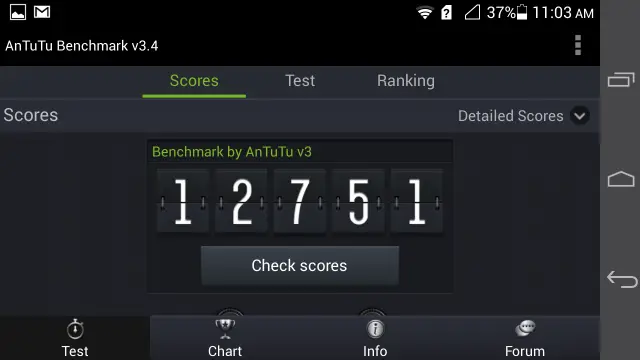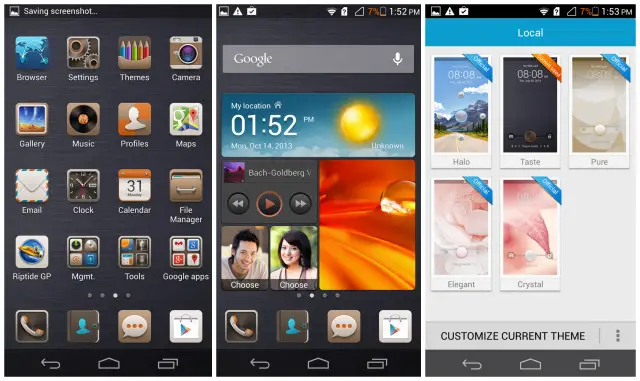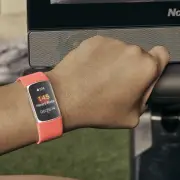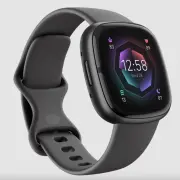The Huawei Ascend P6 is a very interesting device. It’s the Chinese company’s most ambitious one yet, but will ambitions alone be the key ingredient in making a smartphone that appeals to a wide range of people? We’re taking a quick look at it in this lightning review, where we’ll discuss hardware, software, sugar, spice, and everything else that makes it nice. Let’s get into it!
Hardware
The Ascend P6 is one of Huawei’s most carefully designed devices yet, with as much attention being paid to the outside as what’s on the inside. We’ll dive into aesthetics and build quality first, and then take a look at the specs that make this thing tick.
Design and Build Quality
The marquee of the hardware is the beautiful brushed metal construction employed on the Ascend P6. A unibody wonder it is not, but Huawei spared no expense otherwise. The Ascend P6 feels and looks like a solid phone, one that won’t eventually fall apart after just 6 months of rigorous use. It’s that kind of build that you come to appreciate more and more as the days go on. It feels and looks like you spent $500 on the phone, and at the end of the day that’s one of the main things most folks need to justify such an expensive purchase.
As well as it looks, it’s also quite thin. Keeping a slim profile has always been an aspiration of Huawei’s, with the company always working to stay within the top percentile of the world’s thinnest smartphones. While there are too many phones claiming the “thinnest” label to keep track of these days, we’ll just say the Ascend P6 is one of the thinnest devices you’ll be able to buy.
Everything works quite well from a design standpoint, with Huawei electing to go the “less is more” route with their philosophy this go-round. It works, and it works well. No need for an intricately-designed ring around the camera and LED, some obnoxious curve on the back, or a smattering of useless logos — just make the body beautiful, and the rest falls right into place. Kudos, Huawei!
Specs
Of course, the whole “beauty’s only skin deep” mantra still rings just as true today as it always has. We’re really interested in the silicon sitting inside this thing. Let’s jump into a quick rundown of everything the Ascend P6 has to offer:
- 4.7-inch 720p display
- Huawei K3V2 1.5GHz quad-core processor
- 2GB of RAM and 8GB of internal storage (4.8GB user accessible, microSD expansion bay up to 32GB)
- 8 megapixel camera with 1080p HD video recording
- 5 megapixel front camera with 720p HD video recording
- WiFi 802.11 b/g/n
- Bluetooth 3.0 with A2DP and EDR
- microUSB 2.0 with USB on-the-go capability
- aGPS with GLONASS
- 2,000 mAh battery
Aside from a quad-core processor, most people would consider that a mid-range device. While my time with Motorola’s latest phones leave me hesitant to call it that, I can say with certainty that it certainly feels mid-range in use. The 4.7-inch 720p display looks quite crisp and fine, but I felt the quad-core processor didn’t feel as fast as even some dual-core chipsets I’ve used.
Huawei K3V2 1.5GHz quad-core processor
I’m not sure if it’s because of inefficiencies of Huawei’s custom chip or because of the custom Emotion UI sitting on top of Android 4.2.2, but it didn’t always perform like a quad-core device. Even something as simple as swiping between home screens would feel sluggish after a good bit of time. Installing a custom launcher helped things along, but it still wasn’t quite as smooth as I was expecting.
This was one area I was hoping to see Huawei improve this late in the game, but the company’s desire to use in-house chips seems to make for an experience that is just as stale and unimpressive as it’s always been. That’s not to say it’s horrible or doesn’t work, but it’s 2013, and I demand a little more out of a phone claiming to have a quad-core processor.
Battery Life
The 2,000 mAh battery inside the Ascend P6 worried me a bit before receiving this phone, but I decided to throw my fears aside and cross my fingers to hope that Huawei developed some masterful battery optimization technology. Unfortunately, they did not make such a breakthrough. In fact, I feel like this phone takes a very awkward step backward. Remember that period from 2008 through 2011 when pretty much every Android phone had battery issues? Yes, the Ascend P6 is that bad.
I could barely make it through an 8 hour work day in my testing, with the device often topping out at around the 9 hour mark on a consistent basis. This isn’t with heavy usage, either — with light calls, some texts, copious amounts of email and light browsing (adding up to about 2-3 hours of screen-on time) made up most of my day. The phone whimpered after a round of heavy testing, with gaming, YouTube and music giving me just 3-4 hours of usage before begging for some electricity.
The Rest
Nothing else in particular stood out, whether good or bad. GPS, WiFi and Bluetooth work, and they work as well as you’d expect them to. Storage is limited, but that’s what the microSD card slot is for. Cameras gonna cam, and all that good stuff. Things get a tad more interesting once you dig into the software.
Software
Once upon a time, Huawei’s “custom” user interface was little more than a custom launcher with different icons. We liked it that way, because KISS. But the company has gotten a bit more daring with what they call the “Emotion UI.” It’s a deep transformation from the norm of Android, with Huawei putting their own spin on system apps and settings.
The company went for a brighter, more colorful swatch, one that can be customized to fit your personality and style. That said, not all aspects of their user interface are as easy to stomach. Design trends are all over the place, as jumping between apps would fool someone into thinking it was an entirely different phone. The iconography is inconsistent and, in some cases, confusing. And Huawei’s need to try and cram something into every corner they can does more to hurt the experience than anything else.
The launcher is the most frustrating, with Huawei electing to forego the traditional “apps drawer” and put all apps on the home screen. You can customize the apps’ order and add widgets, but you’ll have to deal with a ton of icons one way or another. A decent solution is to put all app icons into a single folder, though I’d be inclined to just download a custom launcher and call it a day.
This is the perfect time to circle back to concerns about performance issues. We’re not sure if this is Emotion UI’s doing or a byproduct of Huawei’s own-built chipset, but the experience isn’t smooth enough for prime time. The slight stutters and jitters when moving throughout apps is especially troubling for someone like me who whisks around a phone like a mad man.
Apps don’t take long to open, and different apps behave differently depending on how well they’re optimized, but this is unbecoming of a phone that claims to be sporting a quad-core processor. We do commend Huawei for trying to add a bit of value to their experience, though. Things like motion controls (pick phone up during a call to lower volume, turn over to mute, etc) and gloves mode (being able to use the device with gloves on) are decent sprinkles on an otherwise disappointing cupcake.
Camera
Huawei’s 8 megapixel backside-illuminated camera sensor is no slouch. The device produces great, clear images in both lowlight and daytime situations. The camera software makes the experience easy enough and does the work of capturing a nice picture for you with a high dynamic range mode, but you can also jump into a subset of settings for ISO, white balance, brightness and more.
There are also a few useful modes for those who like to change it up, with Huawei including their own suite of filters and a panorama mode. Beyond that, the camera interface is pretty solid, standard and clutter free. Oh, and whoever decided that the volume down button should double as a hardware shutter button deserves a very healthy raise in salary.
Take a look at some photo and video samples from the Ascend P6:
It’s one of the few bright spots of this device. We could have used optical image stabilization, of course, but that’s still a fairly new bit of mobile technology that we’re sure Huawei’s working on for future wares. Video performance seemed fine, though you may want to be careful about hitting that noise cancellation microphone, as doing so caused the recording to pick up periodic blips of static.
Verdict
The Huawei Ascend P6 is a beautiful device, but it’s hampered by many issues that can’t be forgiven. Huawei’s quad-core processor should be enough to make this phone perform smoothly, but it ends up performing more like a single-core Snapdragon. It’s not horrible, but definitely not of the level and quality I expect out of such a chipset. More damning than that is horrible battery life that would make it hard for anyone to make it through a full day without having to plug up.
Couple all of that with some questionable software decisions (circumvented with the use of downloadable launchers, but still) and toy-like interface design, and my admiration of the build quality goes right out of the window. We’re just thankful the camera on this thing is passable, otherwise there’d be little “good” to speak of.
The Good
- Build quality and design
- Great display
- Great camera
The Bad
- Huawei’s custom launcher
- Iconography and design
- Underpowered processor / bogged down software
The Ugly
- Battery life terrible enough to make me cry
Final rating: 2/5
















Many people say on xda is that the processor isn’t clocked at 1.5ghz but instead at 1-1.2 because of heat and battery problems, the newest firmware from b111-b116 helps with performance issues and WiFi/battery
Sounds like they took the OG POS ASCEND, injected w/steroids & ended up with……… a BIGGER POS.
Nice work, HUAWEI.
This looks sharp, but running Android with a 2000 mAh battery? Shot yourself on the foot
Am i the only one who is wondering whats up with the guy throwing boxes off of his balcony?
Isn’t it obvious?
The UPS delivery person left boxes of this POS phone @ this poor guys doorstep.
What else would you expect him to do?
Rofl.
Actually they’d just moved in so they were taking boxes to the dumpster. One person tosses them, the other moves them.
Seems like a bad deal for the guy that has to move them… Wouldnt it be a lot more fun to throw boxes down at your friend? :P
The Good
Build quality and design
Great display
Great camera
The Bad
Huawei’s custom launcher
Iconography and design
Underpowered processor / bogged down software
The Ugly
Battery life terrible enough to make me cry
Final rating: 2/5
2 on a scale of 0-5.
That’s a generous rating there,Quentyn.
Are you in a particularly good mood today? ;-)
They got a lot of brownie points for that build quality / design ;)
Gotcha,not all phone reviews are for the superphones.Just havin’ a bit of fun @ HUAWEI’s expense………………..
Yea, haha. I really wanted to like this phone, but sadly Huawei missed the mark here.
So you get a high end feeling POS that is slow and dead before the day is even done?
I understand that as phones gets better and better perceived build quality
gets more important. I think it’s something that should only be considered if the device usage reaches a certain level of polish.
A device in 2013 must first last a whole day with moderate usage and be quick about it.
I know we say benchmarks don’t matter anymore and for the most part they don’t but that only applies to a certain extent, a minimum performance standard still applies I think.
That antutu benchmark is less than half what my S4 gets, that’s really sad for a quad core device, my work phone is a htc first dual core and it gets 15629.
Device to me from this review deserves a 1
K3V2…… it was never good
Use latest firmwares such B111 (official international) or B118 (leaked) or the other numerous Chinese versions. No sluggishness and performs smooth as butter. Antutu benchmarks are 15000 to 16000. No heat issues. And better battery. Unfortunately most of the online reviews make use of old firmware.